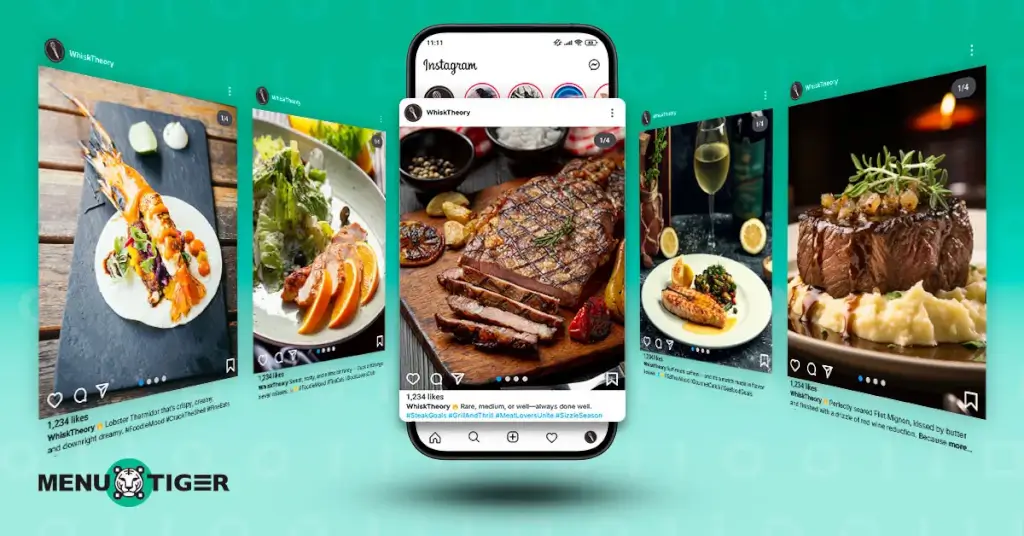
Top 15 Food Presentation Tips to Make Your Dish Shine
Last Updated: October 10, 2025
A food presentation can make you look at a plate of fine dining and think, “That’s it?” Just a tiny piece of meat, a lone leaf, and one elegant swoosh of sauce, yet somehow it costs a hundred dollars.
Why are people so into these artistic and creative displays of food?
Researchers from the MDPI tourism and hospitality journal have identified one key reason behind the trend, which is the influence of social media platforms, particularly Instagram.
This visually appealing presentation of dishes increases its perceived value, and the rise of “foodstagramming” has positively influenced people to visit restaurants based on what they see online.
In this article, we will explore a variety of ideas and techniques to help you craft your next timeless presentation and showcase your creations effectively both on the plate and through digital menus.
What is food plating and presentation?
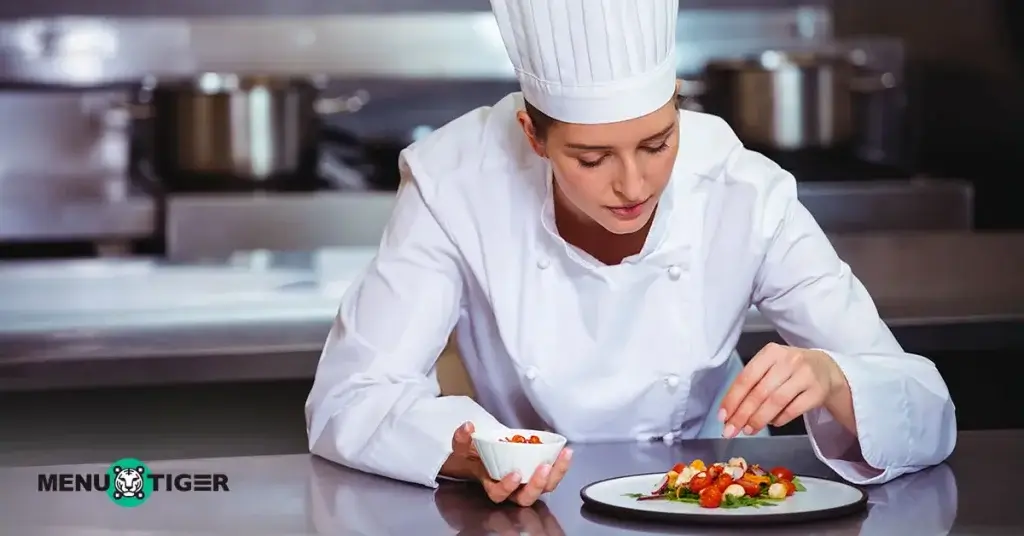
Food plating techniques and presentation are truly the art of making your food look as amazing as it tastes. It is the first impression that sets the tone for the entire dining experience.
The concept of food presentation dates back to Ancient Roman banquets and Medieval feasts, where extravagant dishes and cutlery were used to signify wealth and social status.
Even today, the tradition continues in more subtle ways, like the classic joke about Gen Z and Millennials only bringing out the “good utensils” when important family guests come over.
At its core, this food trend is about more than just appearance. It creates an atmosphere that enhances the overall enjoyment of the meal.
Why is a food presentation important?
Here are the key reasons why food presentation ideas are important:
1. It highlights quality and effort
A messy plate suggests carelessness or a rush job. A carefully arranged plate tells you, “This chef is skilled, and they care about the details.” The “wow” factor creates a positive memory that sticks with you long after the food is gone.
This is why people are often willing to pay more for the same ingredients if they are presented beautifully.
2. Shapes how food taste
One thing about the human brain is that it's wired to judge food visually before our mouth ever gets involved. Simply put, we eat with our eyes first. Take, for example, novelty cakes designed to look like something unappetizing, such as cakes that imitate the appearance of a poop.
Even if someone knows it’s just cake and expects it to taste good, the appearance alone can make them not want to eat it. It just goes to show how much presentation influences what we’re willing to try.
3. Serves as tool for marketing
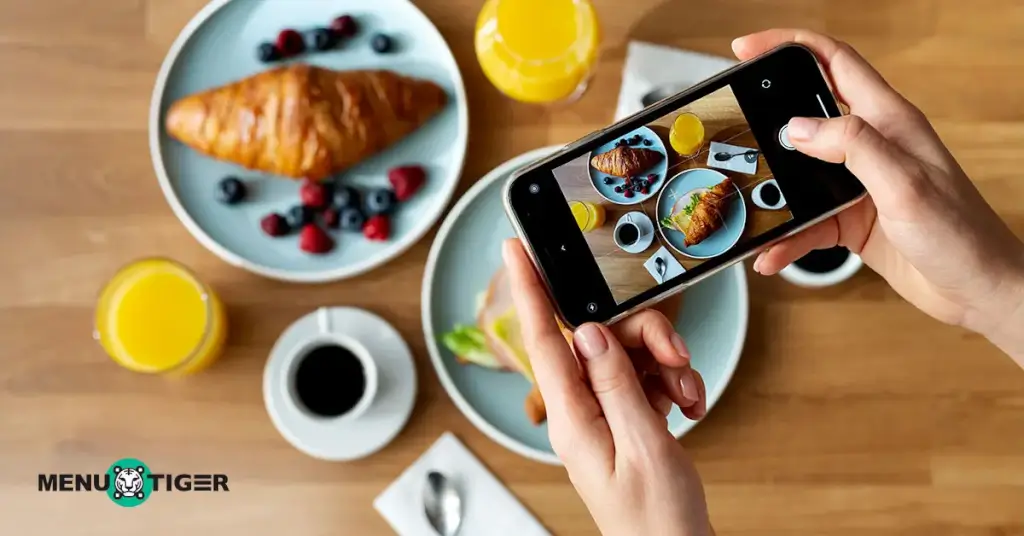
The first thing that often comes to mind with Instagram marketing is the question, “Is it Instagrammable?” If a dish looks visually appealing, customers are likely to take out their phones, snap a photo, and share it with friends or on social media.
With features like “My Day” and “Stories,” sharing content has become quicker and more casual, serving as an alternative to traditional feed posts.
So, eye-catching presentation not only enhances experiential dining but also encourages organic promotion through customer sharing.
4. Encourages mindful eating
A good presentation subtly encourages customers to slow down and focus on what they're eating, which is better for enjoyment and digestion. When food is just piled up on a plate, they tend to eat quickly without thinking.
When a dish is neatly arranged with distinct components, they naturally pause to look at it, appreciate the colors, and think about which part they’ll try next.
5. Communicates the dish's story
Sometimes, the arrangement on the plate is meant to cover memory, a season, a culture or a landscape. For example, a chef might use brown and green elements to mimic a forest floor, making the dish a mini piece of edible art that tells a story about where the ingredients came from.

How to present food like a pro: 15 essential restaurant tips
To create a well-presented dish, here are some important tips to keep in mind:
1. Master the white plate
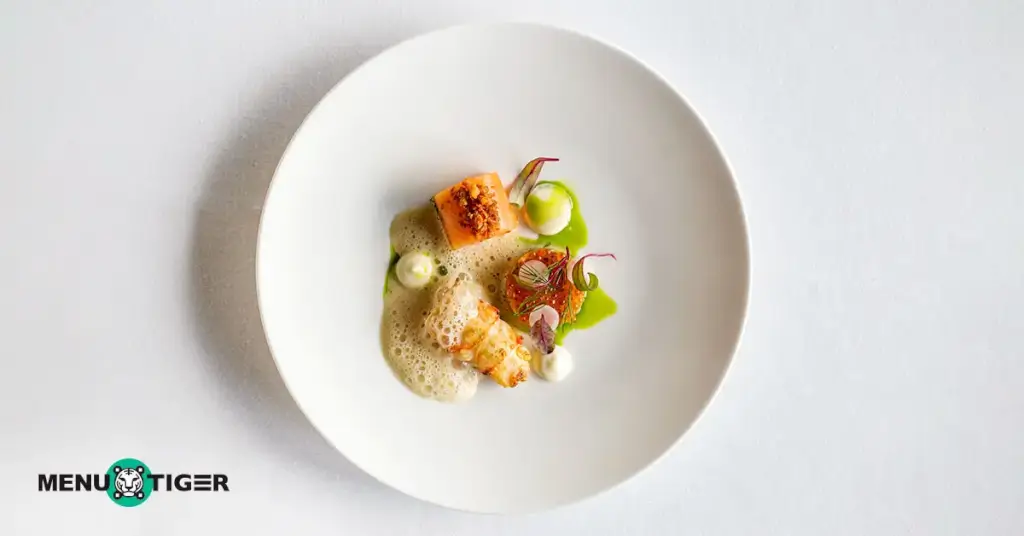
Choose high-contrast plating; your most reliable tool is a plain white plate. It acts as a neutral canvas, forcing the diner's eye to focus 100% on the color and texture of the food.
Using black or other colored plates often hides or dulls the natural vibrancy of the ingredients, so they don’t get the spotlight they deserve.
2. Employ the classic clock layout
Ensure consistency for your kitchen staff. Train your team to plate the mains using the classic arrangement: Protein at 6 o'clock, starch at 10 o'clock, and vegetables at 2 o'clock (from the diner's perspective). This ensures every plate looks uniform.
3. Focus on with negative space
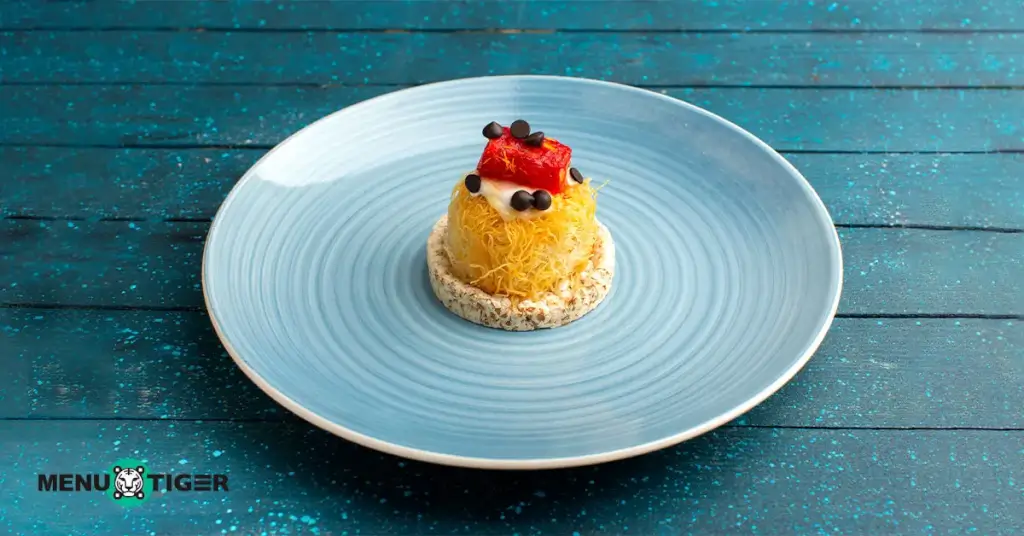
Embrace “less is more.” View the empty space as a design element itself. By strategically clustering your components, you frame the food and prevent the plate from looking cheap or overwhelming. The negative space directs the diner's eye precisely where you want it, giving the dish a luxurious, minimalist appeal.
4. Design for dynamic height
Use a “low-profile anchor” for height. Start with a firm, compact base like a spoonful of soft sides, for instance, build your mash first, then lean your protein against it, and finally, drape a micro-green on top. This layered structure adds depth and prevents components from looking like mere piles.
5. Deliver intentional texture contrast
Every component should offer a textural counterpoint. If you have a mash side, pair it with an ingredient that delivers an audible “snap” or “crunch.” This contrast must be present on the fork, not just on the plate. Think toasted seeds, or thin vegetable chips.
6. Use the rule of asymmetry
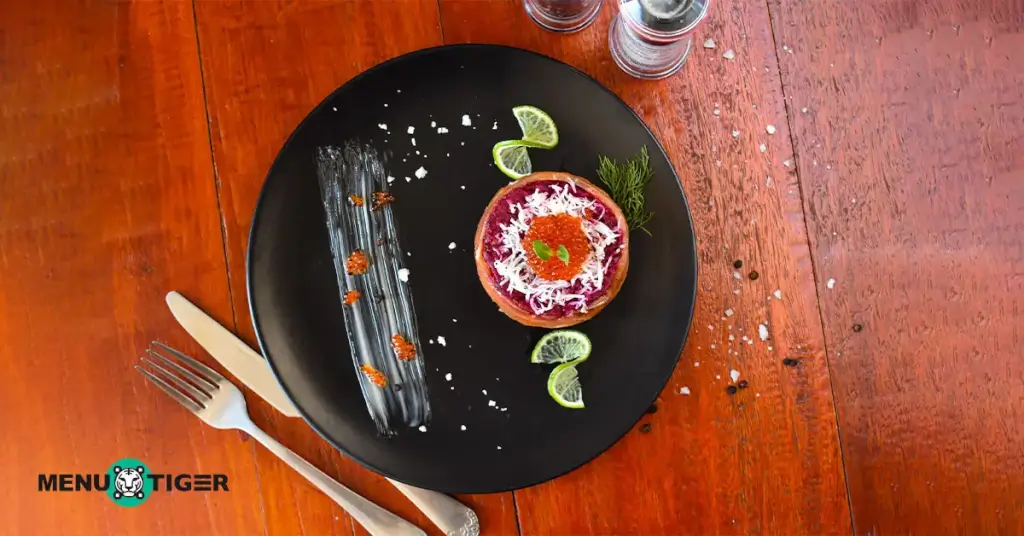
Ditch perfect symmetry. Instead of centering everything, use the Rule of Thirds (like in photography) to position your focal point slightly off-center. Asymmetry creates visual tension and movement, guiding the eye across the plate.
7. Create symmetrical slices
Always slice protein on the bias (against the grain) before plating. Fan out the pieces (shingling) to reveal the perfectly cooked interior and the beautiful crust, showing off the quality of your technique.
8. Use odd numbers for visual harmony
When plating small, round items (scallops, ravioli, cherry tomatoes), always stick to three or five. Our minds find groupings of odd numbers more sophisticated and complete than even-numbered groups, which often feel stiff or too symmetrical.
9. Treat sauces as abstract art
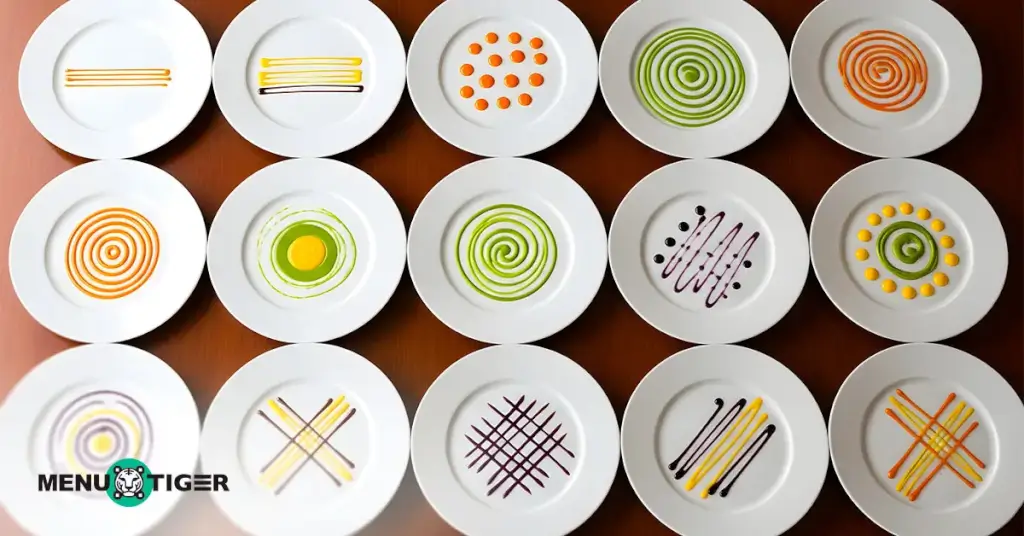
Use squeeze bottles or a precision spoon for controlled sauce application. Instead of pouring, use techniques like the “swoosh” (dragging the back of a spoon) or creating a pattern of small, deliberate dots to add movement and shine.
10. Garnish with a flavorful purpose (keep it edible)
Every garnish must be functional, it should add flavor, texture, or color that complements the dish. Avoid anything inedible or pointless, like huge rosemary sprigs or a slice of raw orange that doesn't fit the flavor profile. Fresh herbs are your best friend here.
11. Prepare a pre-plated components
This is not about presentation but this is to maintain consistency and speed during rush hour. Items like microgreens, toasted crumbs, or pre-sliced garnishes should be stored in small, easily accessible containers or speed racks at the plating station to ensure rapid, consistent application.
12. Maximize color and brightness
Use the color wheel to ensure maximum pop. Pair contrasting colors (like green chives on red beef, or dark sauce with light vegetables) and finish the dish with high-pigment items like citrus zest or bright microgreens.
13. Apply brightness from acid and oil
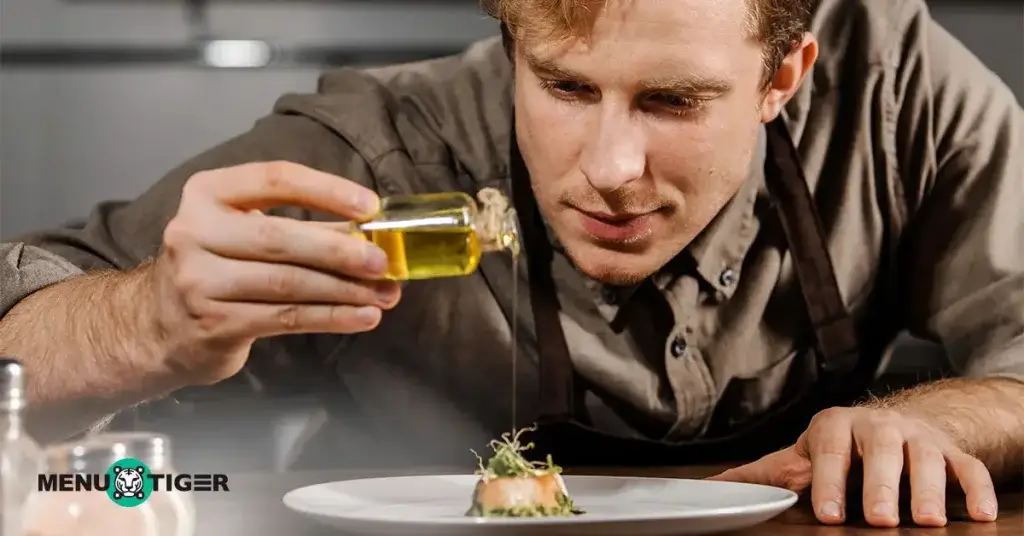
There’s always that specific component like oil that is used for final drizzle. Use a light, flavorful oil (like chive oil or herb-infused oil) to add a layer of sheen to proteins and vegetables, making them look rich and fresh. A squeeze of fresh lemon or lime juice (acid) right before serving also brightens the colours and wakes up the flavors.
14. Have a visual standard on presentation of food
Every new dish requires a master reference photo. A focus on food photography helps create a clear visual standard.
Once the photo is taken, it should be placed prominently in the kitchen pass. This image acts as the absolute standard, ensuring that every cook on every shift replicates the exact arrangement, portion size, and garnish placement.
15. Edit ruthlessly
If an element doesn't enhance the flavor, it doesn't belong on the plate. An expert plate is never decorative for the sake of it. If you're unsure about a garnish or a piece of food, the answer is always to remove it; simplifying the plate is often the final step to perfection.
Beyond the Plate: Best practices to boost online presence
Having a strong online presence is a must if you want your business to grow beyond just your physical location. Start by getting your restaurant technology in place so you will be ready to connect with customers, run things smoothly, and really stand out online.
1. Use a restaurant order management
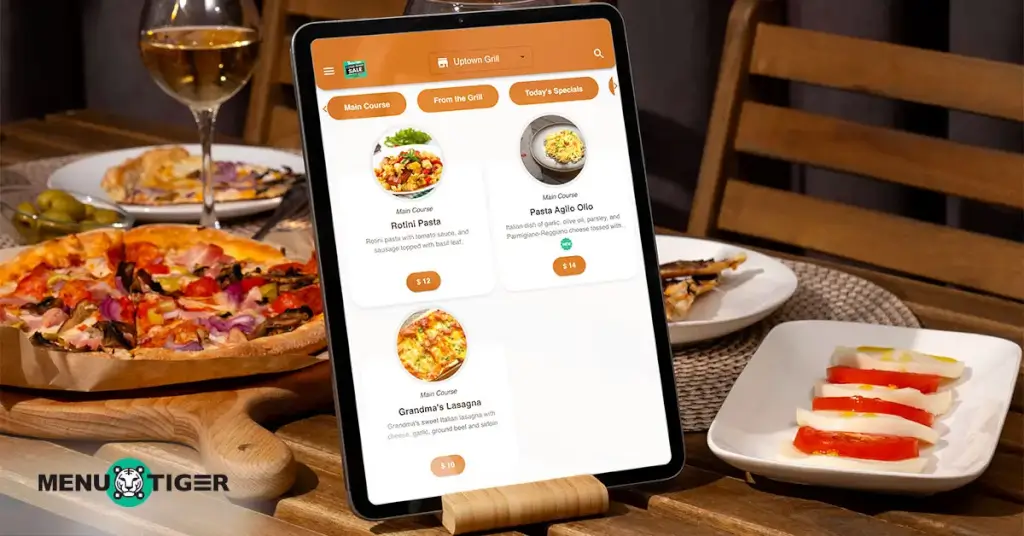
The best restaurant order system offers a complete set of features to build a strong online presence, such as:
- Restaurant website. Usually, customers visit a restaurant website before going to the physical store. A restaurant order management system with a built-in website builder helps you display your menu online and your social media accounts.
- Digital ordering menu. This is one of the most important tools you should have in your restaurant. One issue with printed menus is that they fade over time, and the images lose their impact. When you offer luxurious food, it's essential to ensure the photos stay high quality, and a digital menu offers just that.
2. Post on Instagram
Instagram is one of the most popular social media platforms for posting pictures. Take a great photo using the right angle. Don’t just settle for the raw image. Edit it with filters and effects to enhance its appeal as much as possible.
Additionally, take time to understand the Instagram best time post so you can identify the specific times of day when your audience is most active and engaged.
3. Maintain active social media profiles
Aside from Instagram, platforms like Facebook, and TikTok are great for reaching your audience. Post regularly, engage with followers, share behind-the-scenes content, and use relevant hashtags to increase visibility.
4. Share behind-the-scenes content
Video content is a great way to show off your food. Let people see how your kitchen works or introduce the chef. Show the process of preparing the food.
Record how you plate a dish, pour sauce, or cut into something cheesy or crispy. Keep videos short and eye-catching to grab attention on platforms like Instagram Reels or TikTok.
5. Always ask for reviews
The restaurant social media statistics shows that customers trust online reviews more than personal recommendations. This means that you have to make sure to always ask your customers for reviews.
Good reviews show that your food not only looks great but also tastes great. This helps build trust with new customers and can increase foot traffic to your restaurant.

Ready to start your menu glow-up?
We've gone through all the ideas that turn a regular dish into something amazing. It's clear that a gorgeous food presentation is the key to making a great impression and getting people excited about your menu. Now that you're ready to make every plate a masterpiece, you need to make sure everyone actually sees that beautiful food.
Are you ready to show off those perfectly plated dishes? Get a smart restaurant ordering system.
This way, you can replace those old paper menus with high-quality photos that really capture your food's beauty, carrying that “wow” factor straight from the kitchen to your customer's screen.
FAQS
Eulla
Eulla joined MENU TIGER’s Content Team with a foundation in English teaching. She combines language expertise and creativity to produce engaging content that educates audiences and drives meaningful results.


